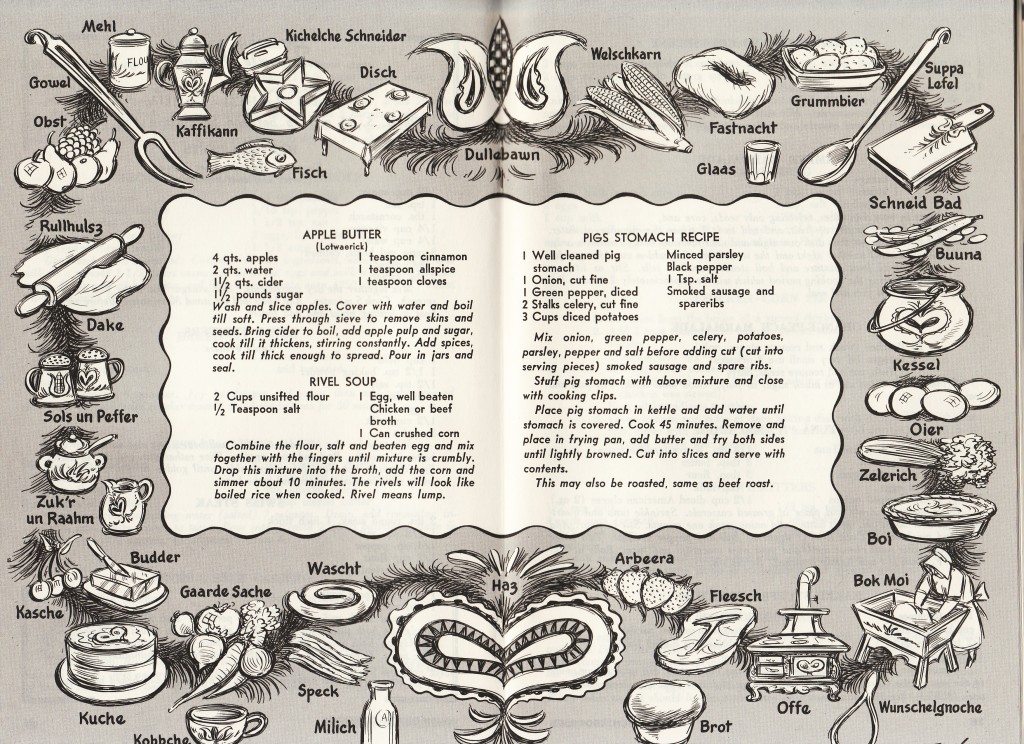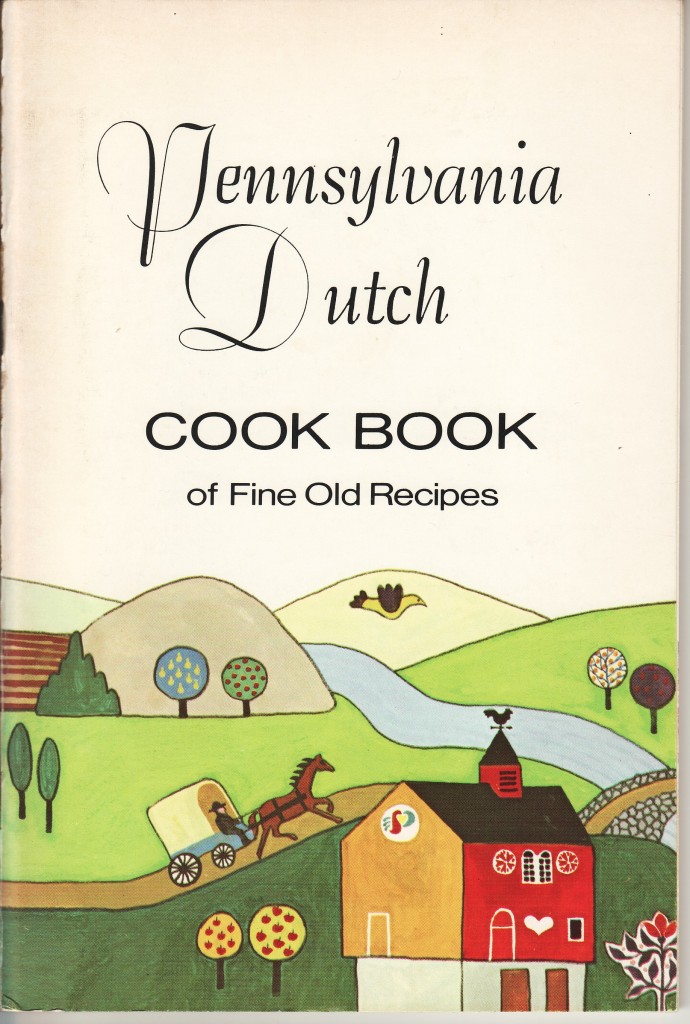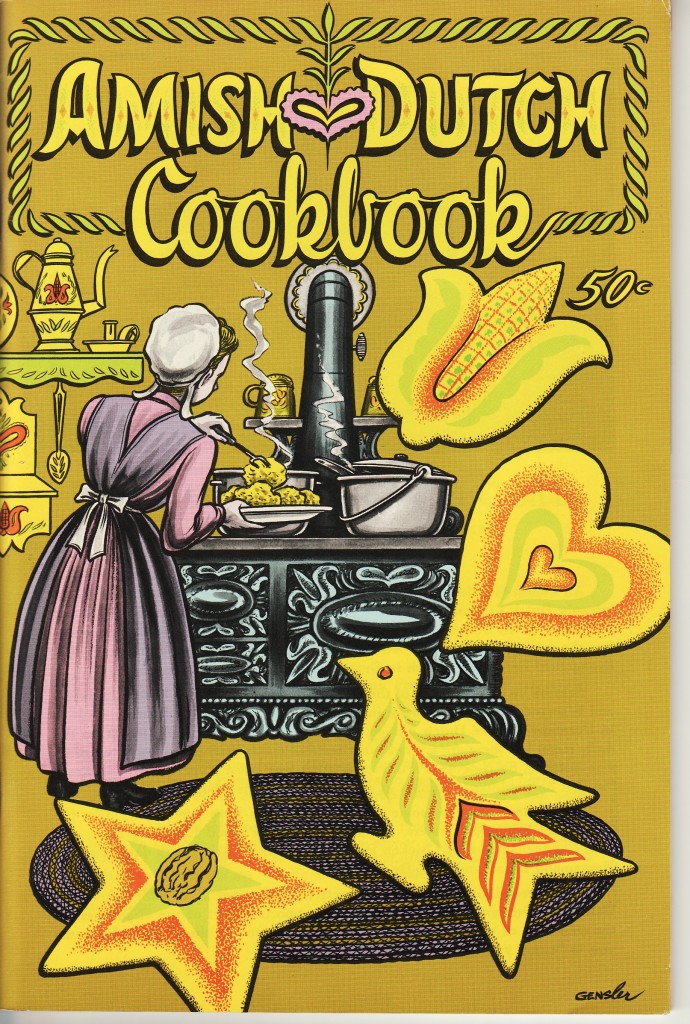Pennsylvania Dutch Meals of the Civil War Period
Posted By Norman Gasbarro on February 13, 2011
A previous post on this topic gave some Pennsylvania Dutch words which were used to describe some basic foods which were common during the Civil War period. This post includes some of the Pennsylvania Dutch words used to name meals, food combinations in recipes, and finally, will give some of the recipes.
As before, the words are taken from The English Pennsylvania Dutch Dictionary and the Pennsylvania Dutch People which includes English “equivalents” by Howard Snader. The “equivalents” are Snader’s suggested ways of pronouncing the words.
Meal Time (EEMS tzeit) & Eating (ESS a)
Breakfast (MORIG a ess a); drank (ge DROONK a); eat (ESS a); food (ESS soch); food (FOOD er); food stuff (LAY wis midd el); hunger (HOONG er); lunch (WENN ich ess a); meal (eems); mouthful (MOWL foll); supper (NACHT ess a); thirsty (DOSCHT ich).
Cooking (KOCH a) and Utensils (KOCH a g’scharr)
Apple butter paddle (LOD wor rick britch); bake (BOK a); baked (ge BOK a); baking (om BOK a); bowl (SCHISS el); bread basket (BOK ka rib): bread board (BRODT board); bread pan (BRODT pon); brew (brow); brewery (BROW er i); bucket (AYE mer); bucket (KIW el); burnt (fer BRENT); cabbage cutter (graut HUH el); cake griddle (KUCH a blot); coffee pot (COFF e konn); condense (TZOMM a drick a); cook (koch); cooking (KOCH a); copper kettle (KOOP er KESS el); cream pitcher (RAWM greek el); distillery (BRENN er i); flour mill (MAIL meel); fork (GOW wel); iron kettle (EYES a KESS el); kettle (Kess el); ladle (SHEPP er); larder (KOMM er); oven (UFF a); bake oven (BOK uff a); potato masher (GROOM beer a SCHTOMP el); pot hook (KESS el HO ga); roast (rowscht); saucer (BLED chia); saucer (BLED ly); slice (schlice); slicer (SCHLICE er); smoke house (SCHMOKE hows); soft boiled (WAICH g’koch’d); soup dish (SUPP a schiss el); soup plate (SUPP a dell er); spatula (SCHEIF ly); spoon (LEFF el); stew pan (SASS pon); stove (UFF a); sweeten (SEES mach a); tablespoon (SUPP a leff el); tea cup (TAY cup chia); tea kettle (TAY KESS el); tea pot (TAY putt); tea set (TAY g’SCHARR); teaspoon (TAY leff el); thicken (DICK er mach a); toast (ge BAY’D brod); waffle iron (WAFF el eyes a); wine glass (WEYE glaws).
Recipes (ree SAYT)
Apple butter (LOD wor rick); apple pie (EBB el boy); apples and dumplings (SCHNITZ un GNEPP); apple sauce (EBB el sass); biscuit (KUCHC a); biscuit (GRACK er); black bread (SCHWARTZ brod); boiled cabbage (WISE GRAUT); bread (brodt); buckwheat cakes (BUCH way tza KUCH a); cake (KUCH a); layer cake (HOCH er KUCH a); cheese cake (KASE kuch a); cherry pie (KARSH a boy); cookie (KUCH a); cucumber salad (GOOM er a tza lawd); dumplings (gnepp); griddle cake (PFANN kuch a); loaf (labe); loaves (labe); oyster cracker (OYSCHT erg rack er); pastry (ge BOCK a soch); pie (boy); pie crust (PIE gruscht); pig’s foot jelly (TZIDD er ly); pig’s foot jelly (GOLL er aw); pot pie (BUD boy); pot pie (BOTT boy); pound cake (POOND kuch a); pretzel (BRETZ el); red beet eggs (RODE ree wa OY er); salad (tza LAWD); sauerkraut (SOW er graut); scrapple (PON hoss); soup (supp); stew (KOCH a).
“Recipes” follow for three Pennsylvania Dutch “meals” or “dishes.”
The first item is apple butter (LOD wor rick) on bread (brodt). While this item is not uniquely Pennsylvania Dutch, it has been firmly adopted and included in the Pennsylvania Dutch culture and cuisine. German immigrants made apple butter so widely that it, with bread, became a meal in itself. Apple butter is made by boiling apple sauce, cider vinegar, and other ingredients for hours, stirring almost constantly, until the mixture turns into a thick paste-like substance. The apple butter paddle (LOD wor rick britch) is used to stir. After cooling, the mixture is spread on bread. Apple butter is preserved by canning which is a process of sealing it in an airtight container. In 1858, the “Mason Jar” was invented in Pennsylvania and thus was available for home “canning” use during the Civil War. Food sealed in a mason jar could last from one to five years. Although preserved in glass jars, the item was referred to as “canned”, named after the process rather than the container.
In The Diary of Henry Keiser, previously referred to in a post on Corp. John C. Gratz, Keiser notes the receipt of apple butter from home. That, with the bread he “drawed” must have made a fine meal for a soldier away from home.
Sunday March 15, 1863. Drawed bread. Our Company was inspected by Capt. J. M. Haas. Joseph Workman returned from furlough this Evening and brought me letters from Mariah and Elizabeth [sisters of Henry Keiser] and a can of apple butter and two pounds of tobacco from home.
The second item scrapple (PON hoss), is uniquely Pennsylvania Dutch. Finding uses for all parts of a butchered pig was not easy, but one part, the head, found its way into the Pennsylvania Dutch diet. Scrapple is usually cut in slices and pan fried. Often a breakfast food, the fried substance can be coated with apple butter or syrup, mixed with potatoes or eggs, and served with bread. The following recipe is from the Pennsylvania Dutch Cookbook of Fine Old Recipes published in 1961 by Culinary Arts Press of Reading, Pennsylvania:
PONHAWS (Scrapple)
Separate one hog’s head into halves. Remove and discard the eyes and brains. Scrape and thoroughly clean the head. Put into a large heavy kettle and cover with four or five qts. of cold water. Simmer gently for 2 to 3 hrs. or until the meat falls from the bones. Skim grease from the surface; remove meat, chop fine and return to liquid in the kettle. Season with salt and pepper to taste and 1 teaspoon of ground sage. Sift in granulated yellow corn meal, stirring constantly, until the mixture is thickened to the consistency of soft mush. Cook over low heat for 1 hr., stirring occasionally, as mixture scorches easily. When cooked, pour the scrapple into greased loaf pans and cool. Cover and store in a cool place. To serve, cut into thin slices and fry in hot fat until crisp and browned.
The final “recipe” will be for Schnitz und Knepp, and will be presented in the form of a poem, which is also from the above named cookbook:
SCHNITZ UND KNEPP
I am a man well up in years with simple tastes and few.
But I would like to eat again a dish my boyhood knew.
A rare old dish that Mother made that filled us all with pep,
This generation knows it not – we called it Schnitz und Knepp.
I patronize all restaurants where grub is kept for sale,
But my search up to the present has been without avail.
They say they never hear of it, and I vainly wonder why,
For that glorious concoction was better far than pie.
Dried apple snits, a slab of ham and mammoth balls of dough
Were the appetizing units that filled us with a glow,
When mother placed the smoking dish upon the the dinner table,
And we partook of its delight as ls long as we were able.
My longing for that boyhood dish I simply will not shelf;
If I cannot find it anywhere, I’ll make the thing myself.
—H. Luther Frees
An actual recipe for Schnitz und Knepp (Apples and Dumplings/Apples and Buttons with Ham) can be found in just about every Pennsylvania Dutch cook book.
This post ends with some art from a booklet entitled Amish-Dutch Cookbook published in 1960 by the Science Press, Ephrata, Pennsylvania.

Click on picture to enlarge and reveal recipes for Apple Butter, Rivel Soup, and Stuffed Pigs Stomach
 ;
;





Comments